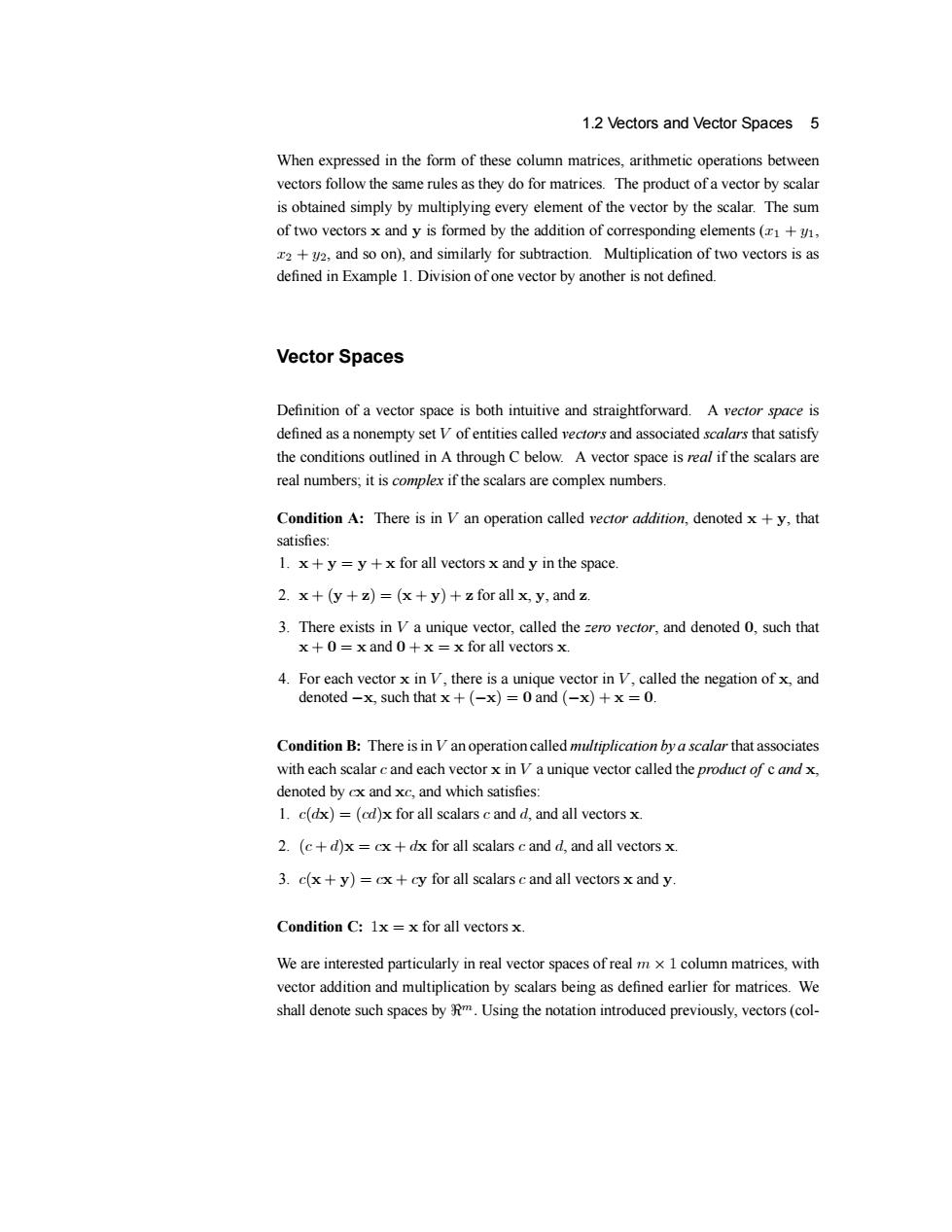正在加载图片...

1.2 Vectors and Vector Spaces 5 When expressed in the form of these column matrices,arithmetic operations between vectors follow the same rules as they do for matrices.The product of a vector by scalar is obtained simply by multiplying every element of the vector by the scalar.The sum of two vectors x and y is formed by the addition of corresponding elements(1+y1, 2+y2,and so on),and similarly for subtraction.Multiplication of two vectors is as defined in Example 1.Division of one vector by another is not defined. Vector Spaces Definition of a vector space is both intuitive and straightforward.A vector space is defined as a nonempty set V of entities called vectors and associated scalars that satisfy the conditions outlined in A through C below.A vector space is real if the scalars are real numbers,it is complex if the scalars are complex numbers. Condition A:There is in V an operation called vector addition,denoted x+y,that satisfies: 1.x+y =y+x for all vectors x and y in the space. 2.x+(y+z)=(x+y)+z for all x,y,and z. 3.There exists in V a unique vector,called the zero vector,and denoted 0,such that x+0=x and 0+x=x for all vectors x. 4.For each vector x in V,there is a unique vector in V,called the negation of x,and denoted-x,such that x+(-x)=0 and (-x)+x=0. Condition B:There is in V an operation called multiplication by a scalar that associates with each scalar c and each vector x in V a unique vector called the product of c and x. denoted by cx and xc,and which satisfies: 1.c(dx)=(cd)x for all scalars c and d,and all vectors x. 2.(c+d)x =cx+dx for all scalars c and d,and all vectors x. 3.c(x+y)=cx+cy for all scalars c and all vectors x and y. Condition C:1x=x for all vectors x. We are interested particularly in real vector spaces of real m x 1 column matrices,with vector addition and multiplication by scalars being as defined earlier for matrices.We shall denote such spaces by m.Using the notation introduced previously,vectors(col-1.2 Vectors and Vector Spaces 5 When expressed in the form of these column matrices, arithmetic operations between vectors follow the same rules as they do for matrices. The product of a vector by scalar is obtained simply by multiplying every element of the vector by the scalar. The sum of two vectors x and y is formed by the addition of corresponding elements (x1 + y1, x2 + y2, and so on), and similarly for subtraction. Multiplication of two vectors is as de®ned in Example 1. Division of one vector by another is not de®ned. Vector Spaces De®nition of a vector space is both intuitive and straightforward. A vector space is de®ned as a nonempty set V of entities called vectors and associated scalars that satisfy the conditions outlined in A through C below. A vector space is real if the scalars are real numbersu it is complex if the scalars are complex numbers. Condition A: There is in V an operation called vector addition, denoted x + y, that satis®es: 1. x + y = y + x for all vectors x and y in the space. 2. x + (y + z) = (x + y) + z for all x, y, and z. 3. There exists in V a unique vector, called the zero vector, and denoted 0, such that x + 0 = x and 0 + x = x for all vectors x. 4. For each vector x in V , there is a unique vector in V , called the negation of x, and denoted ¡x, such that x + (¡x) = 0 and (¡x) + x = 0. Condition B: There isin V an operation called multiplication by a scalar that associates with each scalar c and each vector x in V a unique vector called the product of c and x, denoted by cx and xc, and which satis®es: 1. c(dx) = (cd)x for all scalars c and d, and all vectors x. 2. (c + d)x = cx + dx for all scalars c and d, and all vectors x. 3. c(x + y) = cx + cy for all scalars c and all vectors x and y. Condition C: 1x = x for all vectors x. We are interested particularly in real vector spaces of real m £ 1 column matrices, with vector addition and multiplication by scalars being as de®ned earlier for matrices. We shall denote such spaces by <m: Using the notation introduced previously, vectors (col-